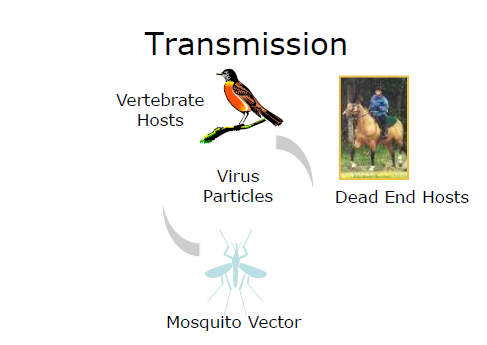Equine Encephalomyelitis
What is it?
Equine encephalomyelitis refers to swelling of the brain and spinal cord in horses and other equids (mules, burros, donkeys and zebras). This swelling that can result in significant neurologic illness and sometimes death can be caused by multiple mosquito-borne viruses including Eastern Equine Encephalomyelitis (EEE), Western Equine Encephalomyelitis (WEE) and Venezuelan Equine Encephalomyelitis (VEE). Some of these viruses affect birds and occasionally other mammals and all can infect humans. Confirmed cases of these viruses in any species are reportable to the Board of Animal Health and VEE is a reportable foreign animal disease and a potential biological weapon.
There were three documented cases of EEE in Minnesota horses in 2001 in Blue Earth, Kanabec and Anoka Counties and two documented cases of EEE in horses in Otter Tail County in 2019. In horses, EEE is fatal in more than 90 percent of cases.
How is it transmitted?
These viruses circulate between mosquitoes and infrequently other bloodsucking insects and wild birds or rodents who serve as a reservoir. When horses are bitten by insects carrying the virus, they’re considered a “dead-end host” meaning they’re unable to transmit the disease to other horses or people. Exposure risk varies based on geographic location and movement of insects and wildlife that may be carrying virus.
 Circulation of the virus by mosquito vector.
What are the clinical signs?
Early signs that an animal is infected with one of these diseases include fever, anorexia and depression. The majority of cases exhibit neurological signs that may include changes in the animal’s behavior: aimless wandering, head pressing, circling, inability to swallow, loss of limb control, involuntary movement, and/or paralysis.
How is it diagnosed?
EEE and WEE can be diagnosed in horses by detecting antibodies in serum. Virus can also be detected in brain tissue after an animal has died.
Is there a risk to people?
Yes, infected mosquitoes can bite people and spread the virus. Symptoms vary, and people should contact their doctor if they experience unexplained fever, chills, body aches or headaches leading to tremors, seizures or paralysis. Even though people cannot contract the disease from horses, cases in horses are a clear indication that infected mosquitoes are in the area and could infect humans. Risk to people is likely highest in the area around detections in horses. The Minnesota Department of Health’s website has resources for people to prevent mosquito-borne disease. https://www.health.state.mn.us/diseases/mosquitoborne/prevention.html
How can it be prevented?
Vaccines are readily available in the U.S. for equine EEE, WEE and VEE.
The Minnesota Board of Animal Health encourages all horse owners to consult their veterinarian to determine the most appropriate and effective vaccines and the frequency of administration.
Clinical illness and fatality in horses can be limited through vaccines and decreased exposure to insects. Reduce disease risk by reducing mosquitoes:
- Change water in drinking troughs every week.
- Mow long grass.
- Drain stagnant water puddles.
- Remove items mosquitoes use for breeding grounds, like old tires and tin cans.
- Place and maintain screens over windows and stable doors.
- Use mosquito repellents to protect horses and people from mosquito bites.
Having trouble viewing this email? View it as a Web page.
|